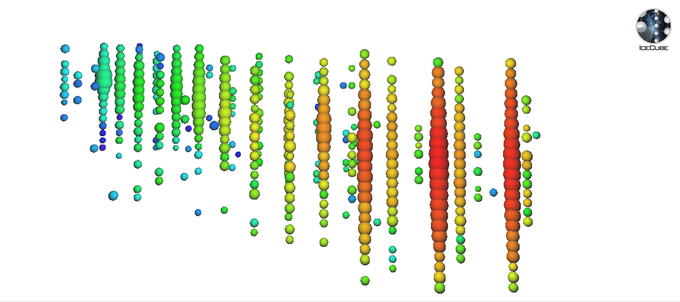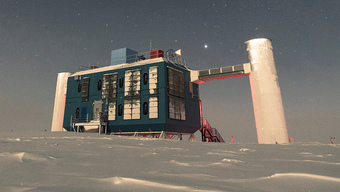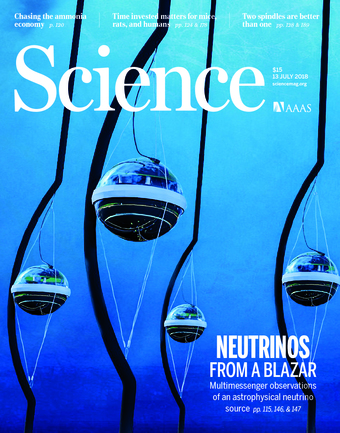Blazar accelerates cosmic neutrinos to highest energies
A century old puzzle solved: First evidence on the source of extragalactic particles
2018-07-18 – News from the Physics Department

To rule out other origins with certainty, the team led by neutrino physicist Elisa Resconi from the Technical University of Munich and multi-wavelength astronomer and blazar expert Paolo Padovani from the European Southern Observatory (ESO) examined a 1.33-degree sky region around the position that a high-energy neutrino that hit the IceCube detector on September 22, 2017 emanated from.
An international cooperation involving Resconi had associated the neutrino to a known blazar with the catalogue number TXS 0506+056 [1] – an active galaxy whose jet of high-energy particles points directly towards Earth. “It is one of the brightest and most peculiar objects ever observed,” says Elisa Resconi.
Many competing objects in the “Open Universe”
For their work the research group led by Resconi and Padovani used, for the first time ever, the open access archive data of “Open Universe”, an initiative under the auspices of the United Nations Committee for the Peaceful Uses of Outer Space developed by astronomer Paolo Giommi, currently a Hans Fischer Senior Fellow at TUM-Institute for Advanced Study.
Using specially designed software, they combed the data from multiple telescopes to characterize the signals. Initially, they found 637 objects, including seven blazar-like objects that might be responsible for the IceCube neutrino. Then, they took a closer look.
TUM team delivers decisive contribution
After careful analysis, only one of the blazars in question was left. This object stood out as a particularly strong source of high-energy gamma radiation during the period from September 2014 to March 2015. During this time frame, IceCube detected further neutrinos emanating from the region of TXS 0506+056, as revealed by a subsequent investigation of all previous IceCube neutrinos since 2008 [2].
“However, our work conclusively shows that the radiation profile of TXS 0506+056 perfectly matches the energies of the neutrinos, so that we can exclude all other sources”, says Paolo Padovani [3].
Unique cosmic messengers

In 2017, Resconi, Padovani and Giommi were the first to connect high-energy IceCube neutrinos with blazars [4]. “Now we can make a decisive contribution to demonstrating that blazars are the sources of cosmic neutrinos,” says Elisa Resconi.
For Resconi, the end of an over one-hundred-year-old search for origins of high-energy cosmic particles also marks a new beginning: “We now know better what to search in the universe”. Neutrinos are the only cosmic messengers that open the door to the highest energy phenomena in the universe.
The elaborate search for the extremely volatile particles
Neutrinos, however, are extremely volatile particles. Since they barely interact with matter, neutrinos pass through virtually every kind of matter unhindered. Even though the IceCube detector with its volume of one cubic kilometer in the Antarctic ice is the largest detector in the world, it is still too small: Since 2013, IceCube has observed only 82 high-energy neutrinos.
That is why Elisa Resconi is working on the design of a network of neutrino telescopes distributed across the Earth. The goal: To increase the number of detected neutrinos so that scientists can do real astronomy to further explore many hitherto poorly understood phenomena of the universe in combination with the other astronomical messengers – electromagnetic waves and gravitational waves.
New TUM neutrino project in the pacific
At the end of June, Resconi’s TUM team successfully launched a brand-new project: In the north-eastern Pacific Ocean, at a depth of 2.7 km below the surface, two 150-meter-long strings with a total of eight detectors were deployed on the sea floor.
“If the characterization of the site proves to be excellent, one could consider how a full-scale neutrino observatory might be deployed on a relatively fast timescale thanks to the existing deep-water infrastructure”, says Resconi. “A neutrino detector array operated in the Pacific would ideally complement IceCube and its second generation at the South Pole Station.”
Publications
- Multimessenger observations of a flaring blazar coincident with high-energy neutrino IceCube-170922AIceCube, Fermi-LAT, MAGIC, AGILE, ASAS-SN, HAWC, HESS, INTEGRAL, Kapteyn, Kanata, Kiso, Liverpool, Subaru, Swift, VERITAS, VLA
- Neutrino emission from the direction of the blazar TXS 0506+056 prior to the IceCube-170922A alertIceCube Collaboration
- Dissecting the region around IceCube-170922A: BL Lac TXS 0506+056 as the first cosmic neutrino sourceP. Padovani, P. Giommi, E. Resconi et al.Monthly Notices of the Royal Astronomical Society, 12 July 2018DOI: n.n.
- Connecting blazars with ultra-high energy cosmic rays and astrophysical neutrinosE. Resconi, S. Coenders, P. Padovani, P. Giommi, L. CaccianigaDOI: 10.1093/mnras/stx498
Further information
The IceCube Neutrino Observatory is funded primarily by the National Science Foundation and is operated by a team headquartered at the University of Wisconsin – Madison.
The construction of IceCube was also funded with significant contributions from the National Fund for Scientific Research (FNRS & FWO) in Belgium; the Federal Ministry of Education and Research (BMBF) and the German Research Foundation (DFG) in Germany; the Knut and Alice Wallenberg Foundation, the Swedish Polar Research Secretariat, and the Swedish Research Council in Sweden; as well as the Department of Energy and the University of Wisconsin–Madison Research Fund in the US.
The IceCube Collaboration comprises over 300 scientists from 49 institutions in 12 countries. In Germany, the following institutions are involved: RWTH Aachen, Humboldt University Berlin, Ruhr University Bochum, TU Dortmund, University Erlangen-Nuremberg, Mainz University, University Münster, Technical University of Munich and University Wuppertal; research funding is provided by the BMBF, the Helmholtz Association, the DFG and by other resources of the participating institutions.
The interdisciplinary collaboration of the research group between Elisa Resconi (TUM) and Paolo Padovani (ESO) was originally initiated by the Cluster of Excellence “Origin and Structure of the Universe” (EXC153), funded by the DFG.
Elisa Resconi’s project in the northeastern Pacific Ocean was conducted in collaboration with Ocean Networks Canada, an initiative of the University of Victoria, Canada, and funded by the DFG through the Cluster of Excellence “Origin and Structure of the Universe” (EXC153) and the Collaborative Research Center 1258 “Neutrinos and Dark Matter in Astro- and Particle Physics”, whose initiator and spokesperson is Elisa Resconi.
Video
Animated video of the detection of neutrinos originating from a blazar at the IceCube detector. (streaming on YouTube) – TUM 2018
Watch the video on youtube
What others report about it
Links
Contacts
- Prof. Dr. Elisa ResconiProfessur für Experimentalphysik mit kosmischen TeilchenSonderforschungsbereich 1258Technische Universität MünchenJames-Franck-Str. 1, 85748 GarchingE-Mail: elisa.resconi@tum.deTel.: +49 89 289 12422
- Dr. Paolo PadovaniEuropäische SüdsternwarteKarl-Schwarzschild-Str. 2, 85748 GarchingE-Mail: ppadovan@eso.orgTel.: +49 89 32006478
- Dr. Paolo GiommiHans Fischer Senior FellowInstitute for Advanced Study (IAS)Technische Universität MünchenLichtenbergstr. 2a, 85748 GarchingE-Mail: paolo.giommi@ssdc.asi.it
